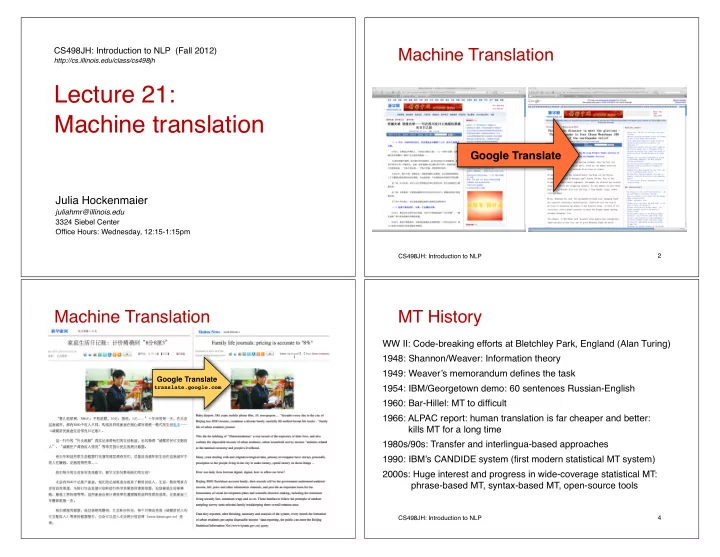

CS498JH: Introduction to NLP (Fall 2012) Machine Translation http://cs.illinois.edu/class/cs498jh Lecture 21: Machine translation Google Translate Julia Hockenmaier juliahmr@illinois.edu 3324 Siebel Center Office Hours: Wednesday, 12:15-1:15pm CS498JH: Introduction to NLP 2 Machine Translation MT History WW II: Code-breaking efforts at Bletchley Park, England (Alan Turing) 1948: Shannon/Weaver: Information theory 1949: Weaver’s memorandum defines the task Google Translate 1954: IBM/Georgetown demo: 60 sentences Russian-English translate.google.com 1960: Bar-Hillel: MT to difficult 1966: ALPAC report: human translation is far cheaper and better: kills MT for a long time 1980s/90s: Transfer and interlingua-based approaches 1990: IBM’s CANDIDE system (first modern statistical MT system) 2000s: Huge interest and progress in wide-coverage statistical MT: phrase-based MT, syntax-based MT, open-source tools CS498JH: Introduction to NLP 3 CS498JH: Introduction to NLP 4
The Rosetta Stone Three different translations of the same text: - Hieroglyphic Egyptian (used by priests) - Demotic Egyptian (used for daily purposes) - Classical Greek (used by the administration) Instrumental in our understanding of ancient Egyptian This is an instance of parallel text: The Greek inscription allowed scholars to decipher the hieroglyphs CS498JH: Introduction to NLP 5 CS498JH: Introduction to NLP 6 Some examples John loves Mary. Jean aime Marie. Why is MT difficult? John told Mary a story. Jean a raconté une histoire à Marie. John is a computer scientist. Jean est informaticien. John swam across the lake. Jean a traversé le lac à la nage . CS498JH: Introduction to NLP 7 CS498JH: Introduction to NLP 8
Correspondences Correspondences John loves Mary. One-to-one: John = Jean , aime = loves , Mary= Marie Jean aime Marie. One-to-many/many-to-one: John told Mary a story. Mary = [ à Marie] [a computer scientist] = informaticien Jean [a raconté] une histoire [à Marie]. Many-to-many: John is a [computer scientist]. [swam across ] = [a traversé à la nage] Jean est informaticien. Reordering required: told Mary 1 [a story] 2 = a raconté [une histoire] 2 [à Marie] 1 John [swam across] the lake. Jean [a traversé] le lac [à la nage]. CS498JH: Introduction to NLP 9 CS498JH: Introduction to NLP 10 Lexical divergences Lexical divergences - The different senses of homonymous words Lexical specificity generally have different translations: German Kürbis = English pumpkin or (winter) squash English brother = Chinese gege (older) or didi (younger) English-German: (river) bank - Ufer (financial) bank - Bank - The different senses of polysemous words Morphological divergences English: new book(s), new story/stories may also have different translations: French: un nouveau livre (sg.m), une nouvelle histoire (sg.f), des nouveaux livres (pl.m), des nouvelles histoires (pl.f) I know that he bought the book: Je sais qu ’il a acheté le livre. I know Peter: Je connais Peter. - How much inflection does a language have? I know math: Je m’y connais en maths . (cf. Chinese vs.Finnish) - How many morphemes does each word have? - How easily can the morphemes be separated ? CS498JH: Introduction to NLP 11 CS498JH: Introduction to NLP 12
Syntactic divergences Syntactic divergences: negation Word order: fixed or free? Normal Negated If fixed, which one? [SVO (Sbj-Verb-Obj), SOV, VSO,… ] do -support, English I drank coffee. I didn’t drink (any) coffee. any Head-marking vs. dependent-marking Dependent-marking (English) the man’ s house Head-marking (Hungarian) the man house- his ne..pas French J’ai bu du café Je n’ ai pas bu de café. du -> de Pro-drop languages can omit pronouns: Italian (with inflection): I eat = mangi o ; he eats = mangi a keinen Kaffee German Ich habe Kaffee Ich habe keinen Kaffee Chinese (without inflection): I/he eat: ch ī fàn = getrunken getrunken ‘no coffee’ CS498JH: Introduction to NLP 13 CS498JH: Introduction to NLP 14 Semantic differences Aspect: - English has a progressive aspect : ‘Peter swims’ vs. ‘Peter is swimming’ An exercise - German can only express this with an adverb : ‘Peter schwimmt’ vs. ‘Peter schwimmt gerade’ Motion events have two properties: - manner of motion ( swimming ) - direction of motion ( across the lake) Talmy: Languages express either the manner with a verb and the direction with a ‘satellite’ or vice versa: English (satellite-framed): he [swam] MANNER [across] DIR the lake French (verb-framed): il a [traversé] DIR le lac [à la nage] MANNER CS498JH: Introduction to NLP 15 CS498JH: Introduction to NLP 16
Recommend
More recommend